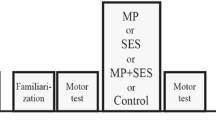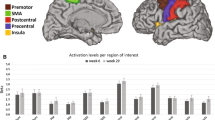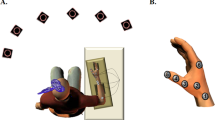Abstract
Somatosensory discrimination training may modulate cognitive processes, such as movement planning and monitoring, which can be useful during active movements. The aim of the study was to assess the effect of somatosensory discrimination training on brain functional activity using functional magnetic resonance imaging (fMRI) during motor and sensory tasks in healthy subjects. Thirty-nine healthy young subjects were randomized into two groups: the experimental group underwent somatosensory discrimination training consisting of shape, surface and two-point distance discrimination; and the control group performed a simple object manipulation. At baseline and after 2 weeks of training, subjects underwent sensorimotor evaluations and fMRI tasks consisting of right-hand tactile stimulation, manipulation of a simple object, and complex right-hand motor sequence execution. Right-hand dexterity improved in both groups, but only the experimental group showed improvements in all manual dexterity tests. After training, the experimental group showed: decreased activation of the ipsilateral sensorimotor areas during the tactile stimulation task; increased activation of the contralateral postcentral gyrus and thalamus bilaterally during the manipulation task; and a reduced recruitment of the ipsilateral pre/postcentral gyri and an increased activation of the basal ganglia and cerebellum contralaterally during the complex right-hand motor task. In healthy subjects, sensory discrimination training was associated with lateralization of brain activity in sensorimotor areas during sensory and motor tasks. Further studies are needed to investigate the usefulness of this training in motor rehabilitation of patients with focal lesions in the central nervous system.




Similar content being viewed by others
References
Aman, J. E., Elangovan, N., Yeh, I. L., & Konczak, J. (2014). The effectiveness of proprioceptive training for improving motor function: a systematic review. Frontiers in Human Neuroscience, 8, 1075.
Binkofski, F., Buccino, G., Posse, S., Seitz, R. J., Rizzolatti, G., & Freund, H. (1999). A fronto-parietal circuit for object manipulation in man: evidence from an fMRI-study. The European Journal of Neuroscience, 11(9), 3276–3286.
Borich, M. R., Brodie, S. M., Gray, W. A., Ionta, S., & Boyd, L. A. (2015). Understanding the role of the primary somatosensory cortex: opportunities for rehabilitation. Neuropsychologia, 79(Pt B), 246–255.
Butefisch, C. M., Wessling, M., Netz, J., Seitz, R. J., & Homberg, V. (2008). Relationship between interhemispheric inhibition and motor cortex excitability in subacute stroke patients. Neurorehabilitation and Neural Repair, 22(1), 4–21.
Carel, C., Loubinoux, I., Boulanouar, K., Manelfe, C., Rascol, O., Celsis, P., et al. (2000). Neural substrate for the effects of passive training on sensorimotor cortical representation: a study with functional magnetic resonance imaging in healthy subjects. Journal of Cerebral Blood Flow and Metabolism: Official Journal of the International Society of Cerebral Blood Flow and Metabolism, 20(3), 478–484.
Carey, L. M., & Matyas, T. A. (2005). Training of somatosensory discrimination after stroke: facilitation of stimulus generalization. American Journal of Physical Medicine & Rehabilitation / Association of Academic Physiatrists, 84(6), 428–442.
Carey, L. M., Matyas, T. A., & Oke, L. E. (1993). Sensory loss in stroke patients: effective training of tactile and proprioceptive discrimination. Archives of Physical Medicine and Rehabilitation, 74(6), 602–611.
Chen, J. C., Lin, C. H., Wei, Y. C., Hsiao, J., & Liang, C. C. (2011). Facilitation of motor and balance recovery by thermal intervention for the paretic lower limb of acute stroke: a single-blind randomized clinical trial. Clinical Rehabilitation, 25(9), 823–832.
Cordo, P., Lutsep, H., Cordo, L., Wright, W. G., Cacciatore, T., & Skoss, R. (2009). Assisted movement with enhanced sensation (AMES): coupling motor and sensory to remediate motor deficits in chronic stroke patients. Neurorehabilitation and Neural Repair, 23(1), 67–77.
Cramer, S. C. (2008). Repairing the human brain after stroke: I. Mechanisms of spontaneous recovery. Annals of Neurology, 63(3), 272–287.
Ebersbach, G., Edler, D., Kaufhold, O., & Wissel, J. (2008). Whole body vibration versus conventional physiotherapy to improve balance and gait in Parkinson’s disease. Archives of Physical Medicine and Rehabilitation, 89(3), 399–403.
Gotts, S. J., Jo, H. J., Wallace, G. L., Saad, Z. S., Cox, R. W., & Martin, A. (2013). Two distinct forms of functional lateralization in the human brain. Proceedings of the National Academy of Sciences of the United States of America, 110(36), E3435–E3444.
Hamdy, S., Rothwell, J. C., Aziz, Q., Singh, K. D., & Thompson, D. G. (1998). Long-term reorganization of human motor cortex driven by short-term sensory stimulation. Nature Neuroscience, 1(1), 64–68.
Herrero, M. T., Barcia, C., & Navarro, J. M. (2002). Functional anatomy of thalamus and basal ganglia. Child’s Nervous System: ChNS: Official Journal of the International Society for Pediatric Neurosurgery, 18(8), 386–404.
Hodics, T., Cohen, L. G., & Cramer, S. C. (2006). Functional imaging of intervention effects in stroke motor rehabilitation. Archives of Physical Medicine and Rehabilitation, 87(12 Suppl 2), S36-42.
Hubbard, I. J., Carey, L. M., Budd, T. W., Levi, C., McElduff, P., Hudson, S., et al. (2015). A randomized controlled trial of the effect of early upper-limb training on stroke recovery and brain activation. Neurorehabilitation and Neural Repair, 29(8), 703–713.
Jouen, A. L., Verwey, W. B., van der Helden, J., Scheiber, C., Neveu, R., Dominey, P. F., et al. (2013). Discrete sequence production with and without a pause: the role of cortex, basal ganglia, and cerebellum. Frontiers in Human Neuroscience, 7, 492.
Kato, H., & Izumiyama, M. (2015). Impaired motor control due to proprioceptive sensory loss in a patient with cerebral infarction localized to the postcentral gyrus. Journal of Rehabilitation Medicine, 47(2), 187–190.
Kelly, A. M., & Garavan, H. (2005). Human functional neuroimaging of brain changes associated with practice. Cerebral Cortex, 15(8), 1089–1102.
Lee, M. Y., Park, J. W., Park, R. J., Hong, J. H., Son, S. M., Ahn, S. H., et al. (2009). Cortical activation pattern of compensatory movement in stroke patients. NeuroRehabilitation, 25(4), 255–260.
Luo, C., Zhang, X., Cao, X., Gan, Y., Li, T., Cheng, Y., et al. (2016). The lateralization of intrinsic networks in the aging brain implicates the effects of cognitive training. Frontiers in Aging Neuroscience, 8, 32.
Lustig, C., Shah, P., Seidler, R., & Reuter-Lorenz, P. A. (2009). Aging, training, and the brain: a review and future directions. Neuropsychology Review, 19(4), 504–522.
Lynch, E. A., Hillier, S. L., Stiller, K., Campanella, R. R., & Fisher, P. H. (2007). Sensory retraining of the lower limb after acute stroke: a randomized controlled pilot trial. Archives of Physical Medicine and Rehabilitation, 88(9), 1101–1107.
Mace, M. J., Levin, O., Alaerts, K., Rothwell, J. C., & Swinnen, S. P. (2008). Corticospinal facilitation following prolonged proprioceptive stimulation by means of passive wrist movement. Journal of Clinical Neurophysiology: Official Publication of the American Electroencephalographic Society, 25(4), 202–209.
Maldjian, J. A., Laurienti, P. J., Kraft, R. A., & Burdette, J. H. (2003). An automated method for neuroanatomic and cytoarchitectonic atlas-based interrogation of fMRI data sets. NeuroImage, 19(3), 1233–1239.
Manganotti, P., Patuzzo, S., Cortese, F., Palermo, A., Smania, N., & Fiaschi, A. (2002). Motor disinhibition in affected and unaffected hemisphere in the early period of recovery after stroke. Clinical Neurophysiology: Official Journal of the International Federation of Clinical Neurophysiology, 113(6), 936–943.
Mathiowetz, V., Kashman, N., Volland, G., Weber, K., Dowe, M., & Rogers, S. (1985). Grip and pinch strength: normative data for adults. Archives of Physical Medicine and Rehabilitation, 66(2), 69–74.
Matyas, F., Sreenivasan, V., Marbach, F., Wacongne, C., Barsy, B., Mateo, C., et al. (2010). Motor control by sensory cortex. Science, 330(6008), 1240–1243.
Merkert, J., Butz, S., Nieczaj, R., Steinhagen-Thiessen, E., & Eckardt, R. (2011). Combined whole body vibration and balance training using Vibrosphere(R): improvement of trunk stability, muscle tone, and postural control in stroke patients during early geriatric rehabilitation. Zeitschrift fur Gerontologie und Geriatrie, 44(4), 256–261.
Mezzapesa, D. M., Rocca, M. A., Rodegher, M., Comi, G., & Filippi, M. (2008). Functional cortical changes of the sensorimotor network are associated with clinical recovery in multiple sclerosis. Human Brain Mapping, 29(5), 562–573.
Nakamura, K., Sakai, K., & Hikosaka, O. (1998). Neuronal activity in medial frontal cortex during learning of sequential procedures. Journal of Neurophysiology, 80(5), 2671–2687.
Nolan, M. F. (1982). Two-point discrimination assessment in the upper limb in young adult men and women. Physical Therapy, 62(7), 965–969.
Oldfield, R. C. (1971). The assessment and analysis of handedness: the Edinburgh inventory. Neuropsychologia, 9(1), 97–113.
Rao, S. M., Binder, J. R., Bandettini, P. A., Hammeke, T. A., Yetkin, F. Z., Jesmanowicz, A., et al. (1993). Functional magnetic resonance imaging of complex human movements. Neurology, 43(11), 2311–2318.
Rosenkranz, K., Butler, K., Williamon, A., & Rothwell, J. C. (2009). Regaining motor control in musician’s dystonia by restoring sensorimotor organization. The Journal of Neuroscience: The Official Journal of the Society for Neuroscience, 29(46), 14627–14636.
Rosenkranz, K., & Rothwell, J. C. (2012). Modulation of proprioceptive integration in the motor cortex shapes human motor learning. The Journal of Neuroscience: The Official Journal of the Society for Neuroscience, 32(26), 9000–9006.
Savini, N., Babiloni, C., Brunetti, M., Caulo, M., Del Gratta, C., Perrucci, M. G., et al. (2010). Passive tactile recognition of geometrical shape in humans: an fMRI study. Brain Research Bulletin, 83(5), 223–231.
Shimizu, T., Hosaki, A., Hino, T., Sato, M., Komori, T., Hirai, S., et al. (2002). Motor cortical disinhibition in the unaffected hemisphere after unilateral cortical stroke. Brain: A Journal of Neurology, 125(Pt 8), 1896–1907.
Shimoyama, I., Ninchoji, T., & Uemura, K. (1990). The finger-tapping test. A quantitative analysis. Archives of Neurology, 47(6), 681–684.
Sirigu, A., Duhamel, J. R., Cohen, L., Pillon, B., Dubois, B., & Agid, Y. (1996). The mental representation of hand movements after parietal cortex damage. Science, 273(5281), 1564–1568.
Stoeckel, M. C., Weder, B., Binkofski, F., Buccino, G., Shah, N. J., & Seitz, R. J. (2003). A fronto-parietal circuit for tactile object discrimination: an event-related fMRI study. NeuroImage, 19(3), 1103–1114.
Struppler, A., Havel, P., & Muller-Barna, P. (2003). Facilitation of skilled finger movements by repetitive peripheral magnetic stimulation (RPMS)—a new approach in central paresis. NeuroRehabilitation, 18(1), 69–82.
Surrey, L. R., Nelson, K., Delelio, C., Mathie-Majors, D., Omel-Edwards, N., Shumaker, J., et al. (2003). A comparison of performance outcomes between the Minnesota rate of manipulation test and the Minnesota manual dexterity test. Work, 20(2), 97–102.
Tesio, L., Simone, A., Zebellin, G., Rota, V., Malfitano, C., & Perucca, L. (2016). Bimanual dexterity assessment: validation of a revised form of the turning subtest from the Minnesota dexterity test. International Journal of Rehabilitation Research. Internationale Zeitschrift fur Rehabilitationsforschung. Revue Internationale de Recherches de Readaptation, 39(1), 57–62.
Tzourio-Mazoyer, N., Landeau, B., Papathanassiou, D., Crivello, F., Etard, O., Delcroix, N., et al. (2002). Automated anatomical labeling of activations in SPM using a macroscopic anatomical parcellation of the MNI MRI single-subject brain. NeuroImage, 15(1), 273–289.
Vahdat, S., Darainy, M., & Ostry, D. J. (2014). Structure of plasticity in human sensory and motor networks due to perceptual learning. The Journal of Neuroscience: The Official Journal of the Society for Neuroscience, 34(7), 2451–2463.
van Nes, I. J., Geurts, A. C., Hendricks, H. T., & Duysens, J. (2004). Short-term effects of whole-body vibration on postural control in unilateral chronic stroke patients: preliminary evidence. American Journal of Physical Medicine & Rehabilitation / Association of Academic Physiatrists, 83(11), 867–873.
van Nes, I. J., Latour, H., Schils, F., Meijer, R., van Kuijk, A., & Geurts, A. C. (2006). Long-term effects of 6-week whole-body vibration on balance recovery and activities of daily living in the postacute phase of stroke: a randomized, controlled trial. Stroke; A Journal of Cerebral Circulation, 37(9), 2331–2335.
Ward, N. S., Brown, M. M., Thompson, A. J., & Frackowiak, R. S. (2003a). Neural correlates of motor recovery after stroke: a longitudinal fMRI study. Brain: A Journal of Neurology, 126(Pt 11), 2476–2496.
Ward, N. S., Brown, M. M., Thompson, A. J., & Frackowiak, R. S. (2003b). Neural correlates of outcome after stroke: a cross-sectional fMRI study. Brain: A Journal of Neurology, 126(Pt 6), 1430–1448.
Wolpert, D. M., & Ghahramani, Z. (2000). Computational principles of movement neuroscience. Nature Neuroscience, (3 Suppl), 1212–1217.
Wong, J. D., Kistemaker, D. A., Chin, A., & Gribble, P. L. (2012). Can proprioceptive training improve motor learning? Journal of Neurophysiology, 108(12), 3313–3321.
Worsley, K. J., & Friston, K. J. (1995). Analysis of fMRI time-series revisited–again. NeuroImage, 2(3), 173–181.
Yozbatiran, N., Donmez, B., Kayak, N., & Bozan, O. (2006). Electrical stimulation of wrist and fingers for sensory and functional recovery in acute hemiplegia. Clinical Rehabilitation, 20(1), 4–11.
Author information
Authors and Affiliations
Corresponding author
Ethics declarations
Funding
None.
Conflict of interest
E. Sarasso, F. Temporiti, P. Adamo, F. Piccolo, R. Gatti report no disclosures.
F. Agosta is Section Editor of NeuroImage: Clinical; has received speaker honoraria from ExceMED – Excellence in Medical Education and Biogen Idec; and receives or has received research supports from the Italian Ministry of Health, AriSLA (Fondazione Italiana di Ricerca per la SLA), and the European Research Council.
M. Copetti has received compensation for consulting and/or serving on advisory boards from Teva Pharmaceuticals and Biogen Idec.
M. Filippi is Editor-in-Chief of the Journal of Neurology; serves on a scientific advisory board for Teva Pharmaceutical Industries; has received compensation for consulting services and/or speaking activities from Biogen Idec, ExceMED, Novartis, and Teva Pharmaceutical Industries; and receives research support from Biogen Idec, Teva Pharmaceutical Industries, Novartis, Italian Ministry of Health, Fondazione Italiana Sclerosi Multipla, Cure PSP, Alzheimer’s Drug Discovery Foundation (ADDF), the Jacques and Gloria Gossweiler Foundation (Switzerland), and ARiSLA (Fondazione Italiana di Ricerca per la SLA).
Ethical approval
All procedures performed in studies involving human participants were in accordance with the ethical standards of the institutional research committee and with the 1964 Helsinki declaration and its later amendments or comparable ethical standards.
Informed consent
Informed consent was obtained from all individual participants included in the study.
Rights and permissions
About this article
Cite this article
Sarasso, E., Agosta, F., Temporiti, F. et al. Brain motor functional changes after somatosensory discrimination training. Brain Imaging and Behavior 12, 1011–1021 (2018). https://doi.org/10.1007/s11682-017-9763-2
Published:
Issue Date:
DOI: https://doi.org/10.1007/s11682-017-9763-2




